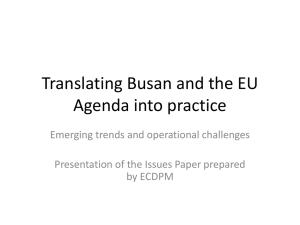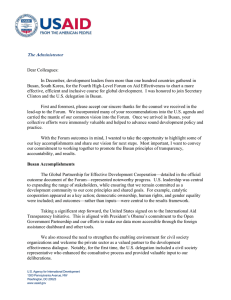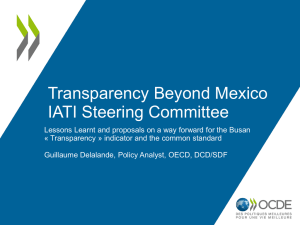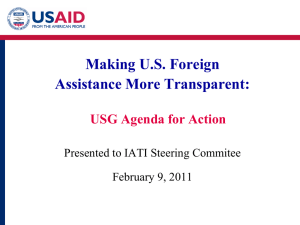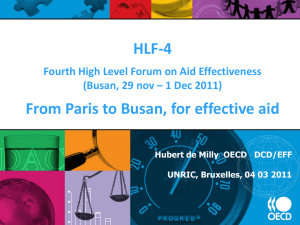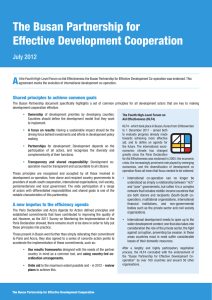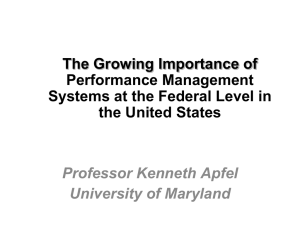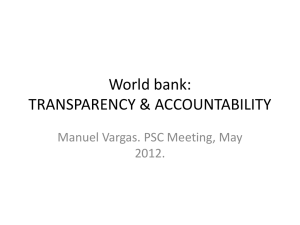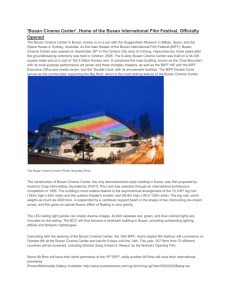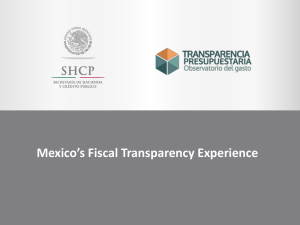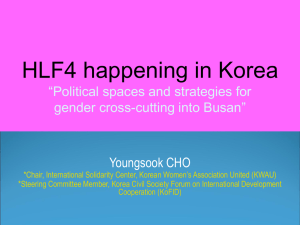Presentation of EC DEVCO A3 - Practitioners Network of European
advertisement
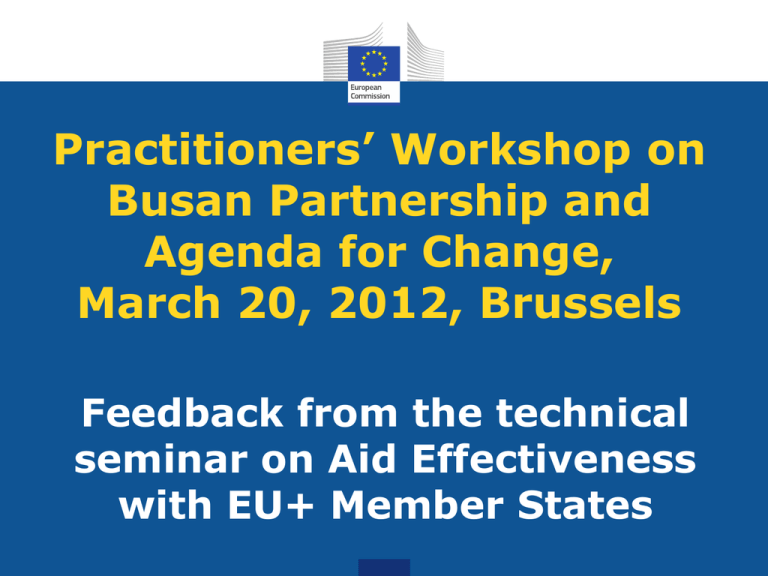
Practitioners’ Workshop on Busan Partnership and Agenda for Change, March 20, 2012, Brussels Feedback from the technical seminar on Aid Effectiveness with EU+ Member States Overview of themes discussed during technical seminar of March 13+14, 2012 • Session 1: Busan follow-up at the global level: • - Aid effectiveness governance structure – global partnership for effective development cooperation • - Monitoring after Busan • Session 2: Busan Building Blocks: PN • - overview of EU MS/COM involvement • Session 3: Joint Programming: PN • - programming guidelines for next MFF / synchronisation • Session 4: Transparency: PN • - TR-Aid • - EU Transparency Guarantee – Busan commitments on transparency • Session 5: Fast Track Initiative on division of labour: • - Ideas for future work 2 Overview of themes tackled: 3 general comments (1) Informal brainstorming => no formal conclusions/quotations, no Common position on new ideas, no formal agreements (2) Discussions mainly at policy level… (3) « Early » phase: COM/EU has not the replies yet on all implementation issues… 3 Practitioners’ Workshop on Busan Partnership and Agenda for Change, March 20 2012: BUSAN & BUILDING BLOCKS Thematic priorities listed in the Busan Common Position Inclusive, globally light and country focused EU contribution to the PBIG process: Ownership Results and accountability Transparency and predictability Reduced fragmentation and countries receiving insufficient assistance Alignment and use of country systems •- private sector; •- inclusive partnerships operationalised at the country level 5 8 Building Blocks : one way to implement • • • • Voluntary initiatives to implement Busan commitments Focus on country level implementation Varying degree of activity and participation No formal accountability mechanism Building Blocks: Conflict & fragility/New Deal: South-south cooperation: Private sector : Climate finance: Transparency: Effective institutions & policies: Results & accountability: Managing diversity & reducing fragmentation: Gender action plan 6 PN Workshop on Busan Partnership and Agenda for Change, March 20 2012: JOINT PROGRAMMING Joint Programming – context • Longstanding undertaking, failed implementation of 2007 Council Conclusions (Code of Conduct on Complementarity and Division of Labour) • New Momentum: Council Conclusions for Busan (EU deliverable), Agenda for Change • Aid effectiveness purpose: • • • Reduced fragmentation through division of labour Increased transparency and predictability EU donors as part of problem and solution Strengthened EU external action purpose: joint undertaking COM-EEAS Final product: single joint programming document, hopefully replacing at least partly individual programming documents 8 Joint Programming – Main features • Scope • Joint analysis/response to partner countries’ national plans • In-country division of labour for all sectors of intervention (not cross-country division of labour) • Indicative financial allocation per sector and donor • Not bilateral implementation plans Change of approach • Focus work at partner country level: “Brussels light” approach • Synchronisation of the EU with partner countries’ cycles: ownership by partner country government • Flexibility: no “one size fits all” • Open to committed non-EU donors, but EU as a driving force 9 Joint Programming – Next steps • Letter from HR/VP Ashton, Commissioners Piebalgs and Füle: • HoMs reports received early March from the potential 11 partner countries • About 6 countries expected to conduct joint programming in 2012 • Next steps: to be decided on the basis of the 2012 experience 10 PN Workshop on Busan Partnership and Agenda for Change, March 20 2012: Transparency Transparency: Introduction Aid transparency after Busan: Transparency to the frontline: a shared principle & timebound commitments Joint Programming & EU Transparency Guarantee = 2 key deliverables for EU and MS in the Busan Forum. (EU Transparency Guarantee: EU MS will publicly disclose all information on aid programmes so that it can be more easily accessed, shared and published) EU commitments from (1) Busan, (2) EU Transparency Guarantee and (3) Operational Framework 12 Transparency: commitments - agreeing (by end 2012) and implementing (by 2015) a common, open standard for electronic publication of timely, comprehensive and forward-looking information on resources provided through development cooperation, and - providing (by 2013) available, regular, timely rolling three-to five-year indicative forward expenditure and/or implementation plans to all developing countries. 13 Transparency: a global standard • - no global standard yet; diverging views • • - a possibility: current International Aid Transparency Initiative (IATI) as a basis Discussion on implementation of transparency commitments: EU Transparency Guarantee and Busan commitments Status of implementation in the Member States, prospects and support needs and state of play & role of the TR AID tool. 14 Transparency: TR-AID tool Transparent Aid (TR AID) tool to combine and visualise EU aid and humanitarian aid data from different sources. COM is further developing the tool in cooperation with EU MS with a view for a launch and publication in the latter part of 2012. Operational Framework: “The EU and its Member States will further explore the possibility of using Transparent Aid (TR AID) to ensure that information can be easily accessed, shared and, eventually, published.” “…first phase, starting in 2011 with a view to the HLF4 in Busan...” “…an assessment of experience in the first phase, by the end of 2012, the EU and its Member States will decide whether to move to a full-fledged EU-wide roll-out of TR AID.” 15 PN Workshop on Busan Partnership and Agenda for Change, March 20, 2012: Questions…?
